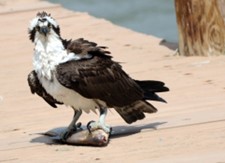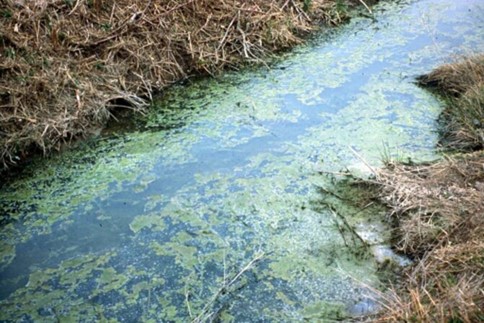Gerald Winegrad: The sad state of the Chesapeake Bay and advocacy for its restoration
Commentary by GERALD WINEGRAD

The symbol of Chesapeake spring, a returning osprey. The 1972 ban on DDT saved this feisty bird. (Carol Swan/Courtesy photo)
Before we drill down into the sad state of the Chesapeake Bay and the lack of aggressive advocacy for its restoration, here’s a wildlife report from Oyster Creek.
The first osprey was seen over the creek on March 9, arriving after a long flight from the south, perhaps from Colombia or Venezuela. Bald eagles have been seen almost daily. They like to perch in the osprey nest between the creek and bay but will allow the ospreys to nest there.
We still have buffleheads and scaups on the creek with the ubiquitous resident mallards and Canada geese. I saw Tundra Swans on the bay off of Bay Ridge. And we had a muskrat swimming under our pier not long ago.
On land, many avian species are active as they are fueling up for the mating and chick-rearing season. Bluebird males are striking in their mating plumage, very nice eye candy. Goldfinches have been devouring my nyjer seed while house finches, house sparrows, cardinals, Carolina chickadees and tufted titmice dine from my regular bird seed feeder.
Mourning doves, white-throated sparrows and dark-eyed juncos scrabble on the ground for spilt seed while Carolina wrens visit the suet feeder with downy woodpeckers and white-breasted nuthatches. We never cease to be in awe of nature’s beauty and how fortunate we are to live on the water in the heart of Chesapeake Bay Country, viewing eagles and ospreys from our bedroom.
But the Chesapeake is in real trouble. After 40 years of formal efforts to restore water quality and ensure its critters thrive once again, the best thing that can be said of the results is that the bay has not gotten worse over the last 40 years.
This is despite more than five million people being added to 13 million in its watershed since 1983. This conclusion was reached by 50 top bay scientists on the Bay Program’s Scientific and Technical Advisory Committee.
The main failure is not adequately controlling agricultural nutrients and sediment that are choking the bay system. Farmland covers two million acres of Maryland, 32% of its land mass. Farming is a leaky business, especially from the massive chicken industry growing about 600 million birds a year producing 1.6 million pounds of chicken litter, mostly poop.
The results are increasing life-threatening, flesh-eating diseases from water contact, collapsed or collapsing fisheries and the failure to restore important submerged bay grasses.

Patty Peacock’s vibrio infection from Harness Creek water contact while tending her crab pot. Her arm and perhaps life were saved by early intravenous antibiotics. (Courtesy of Patty Peacock)
Patty Peacock’s flesh-eating infection from tending her crab pot and cutting her arm on Harness Creek, another victim of excess nutrients fueling vibrio bacteria in our waters. (Patty Peacock/Courtesy photo)
The threat of necrotizing fasciitis from a vibrio infection like Patty Peacock’s and many others presents an ongoing reminder to me that we must do much more to save the bay. I tend our two crab pots every summer day and am cognizant of the threat to my life and limbs. I now wear a long-sleeved shirt and gloves, as does Peacock. I must warn my grandchildren, nieces and nephews who swim in our waters not to go in if they have any cuts.
Is this what we want for our future?
I suffer from extreme disappointment at the current status of the Chesapeake Bay as it dies a death from a thousand cuts, poisoning those coming into contact with its waters. This is one of the few times since leaving office in 1995 that I wish I was still in the Senate to try and force the necessary changes.
I know it is a different world politically, but in the good old days as chairman of the Senate Environment and Chesapeake Bay Subcommittee, I worked closely with conservation organizations, bringing them together on a broad environmental agenda. I insisted we all work together on this common strategy for the Chesapeake and our state’s betterment.
We were able to recruit other legislators rallying around the bay cleanup and were frequently joined by the governor and his environmental agencies on both legislative and budgetary issues. Our job was to overcome inertia and special interests, and prod the legislature to act, leading other states to do the same.
There were many legislative victories and some harsh defeats, none worse than the failure to rein in agricultural pollutants.
In 1982, while still in the House of Delegates, I did gain enactment of the Maryland Agricultural Cost-Share Program with the support of Gov. Harry Hughes and his bay staffer, John Griffin.
This program has provided farmers with thousands of grants totaling more than $200 million to implement best management practices to reduce nutrients and sediment. With other federal and state programs, farmers have been given more than $2 billion to stop polluting the bay. It has had only meager results.
Sadly, gone are the days of annual Chesapeake Bay legislative initiatives supported by the conservation community and the governor. The aura and glow of restoring the Chesapeake seem to have been subsumed by global warming, plastic bag bans and the like.
Of course, warming waters present grave threats to the bay, including the loss of marshes, but nutrients still pose the gravest threats and are not being adequately addressed from farmland and developed lands.
The Maryland League of Conservation Voters has moved to focus nearly exclusively on global warming. The $34 million a year Chesapeake Bay Foundation in 2005 decided to go soft on agriculture and simply throw more money into voluntary actions. This failed strategy includes a failure to force better regulation of the giant poultry industry. CBF has received more than $21 million in grants to work on voluntary efforts in agriculture.
So, the decision by the EPA and bay states to all but abandon the 2010 Chesapeake pollution reduction mandate to be achieved by 2025, has gone mostly unchallenged by conservation groups. Just a few fiery riverkeepers chose to speak out on this sellout of the bay.

Nutrients and sediment from Maryland’s 2 million acres of farms covering 32% of the state are the largest pollution source and the most unregulated. (Chesapeake Bay Program)
Agriculture is the major source of pollutants that are preventing bay restoration and the least regulated. (Chesapeake Bay Program)
While the EPA and bay states recalibrate and take two years to develop yet another plan to meet the Clean Water Act requirements for water quality, not one bold initiative has been undertaken to achieve the necessary reductions in nutrients required by 2025.
The most significant measure of how badly bay restoration is failing is the EPA Bay Program’s data showing that 71.9% of the bay’s waters remain impaired (this means polluted) under the Clean Water Act.
This means they do not meet basic CWA requirements. In 1985, 73.5% of bay waters were impaired. After 40 years and billions spent, this is a very marginal 1.6% improvement. The CWA requires 100% of bay waters to meet basic clean water requirements.
Instead of the EPA forcing bay states to enact measures to comply with the 2025 pollution limits and sanctioning recalcitrant states, the EPA and bay states happily are punting without repercussions from an acquiescent environmental community.
The two-year hiatus to produce another plan might move the goalposts closer, blame climate change and leave us, sadly, with a degraded Chesapeake Bay threatening life and limb and its living resources.
Gerald Winegrad represented the greater Annapolis area as a Democrat in the Maryland House of Delegates and Senate for 16 years. Contact him at gwwabc@comcast.net.